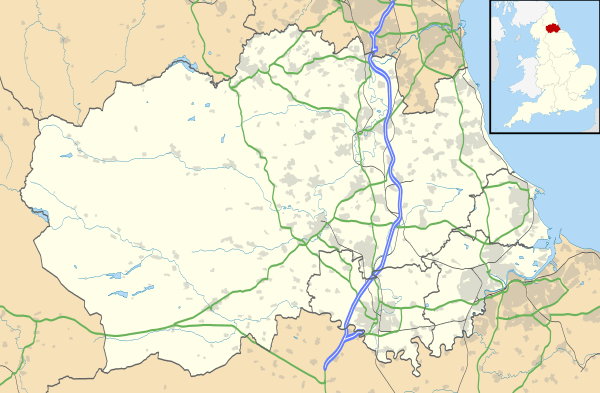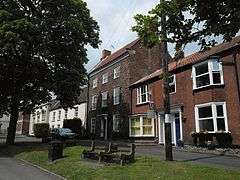Sedgefield
| Sedgefield | |
 St Edmund's Church at Sedgefield |
|
 Sedgefield |
|
| Population | 5,211 (2011) |
|---|---|
| OS grid reference | NZ354286 |
| Civil parish | Sedgefield |
| Unitary authority | County Durham |
| Ceremonial county | County Durham |
| Region | North East |
| Country | England |
| Sovereign state | United Kingdom |
| Post town | STOCKTON-ON-TEES |
| Postcode district | TS21 |
| Dialling code | 01740 |
| Police | Durham |
| Fire | County Durham and Darlington |
| Ambulance | North East |
| EU Parliament | North East England |
| UK Parliament | Sedgefield |
|
|
Coordinates: 54°39′N 1°27′W / 54.65°N 1.45°W

Sedgefield is a town and civil parish in County Durham, England. It has a population of 4,534,[1] increasing to 5,211 at the 2011 census.[2]
A Roman 'ladder settlement' was discovered by Channel Four's Time Team programme in 2003, in fields just to the west of Sedgefield. It consisted of rows of crofts and workshops on either side of a north-south trackway, which could be securely dated by the many finds of Roman coins.
St Edmund's church in Sedgefield is noted for its ornate 17th-century Cosin woodwork, unique to County Durham after the furnishings in Brancepeth were destroyed in a fire.
The 18th century saw the architect James Paine commissioned by John Burdon in 1754 to design and construct a Palladian estate at nearby Hardwick Hall. The building work was never completed as Burdon went bankrupt, but sufficient landscaping was done to form the basis of the now renovated Hardwick Hall Country Park.
The 19th-century South African politician and industrialist Henry Barrington was born in Sedgefield, and actions by his offspring indirectly led to the South African town of Sedgefield, Western Cape being named in honour of his birthplace.
In the 19th century, Sedgefield was a great hunting centre, dubbed 'the Melton of the North'. Hunter Ralph Lambton had his headquarters at Sedgefield: the humorous writer, Robert Smith Surtees, who lived at Hamsterley Hall, was a friend of his. On 23 February 1815, Lord Darlington wrote: 'Mr Ralph Lambton was out with some gentlemen from Sedgefield, and a most immense field.'
Sedgefield was also known in the area because of Winterton Hospital. This was an isolation hospital and an asylum. The site was like a village itself with its own fire station, bank and cricket team. Today, little trace is left of the hospital, apart from the church, which is now surrounded by the Winterton housing estate and the NETPark Science park.
Sedgefield is twinned with Hamminkeln, Germany.
Landmarks
St. Edmund's Church

The parish of St Edmund was founded by Bishop Cutheard, around AD 900. The Normans replaced the original wooden church with the present stone building with rounded arches and the present church was built between 1246 and 1256, in Norman times, to replace the original wooden church, with later additions. The tower was added in the 15th century by Robert Rodes. The church contains some fine brasses and 17th century woodwork.[3]
Ceddesfeld Hall
Ceddesfeld Hall was originally the rectory to the church, built after the first rectory burnt down; it is now occupied by the Sedgefield Community Association. A Latin inscription above the door states, "By the generosity of Samuel and Shute Barrington, one an Admiral of the Fleet, the other Bishop of Durham, whose achievements are praised by everyone." The hall was rebuilt in 1793, by the Barringtons, for their nephew, the rector. The grounds, now a public area, were laid out in the mid-18th century to a design by Joseph Spence.[3]
Manor House
The Manor House occupies a prominent position at the head of the green. With three storeys it is a fine example of Queen Anne style architecture. Built in 1707, as the sundial on the house proclaims, the house was part of the Hardwick Estate, until 1923. The house has been carefully restored and is currently used as a venue for weddings and events as well as being a business hub.[3]
Parish Hall
The Parish Hall was founded in 1849 as the Institute of Literature and Science, but later rebuilt as a Mechanics Institute. The hall was extensively refurbished in 2008, and continues to host a wide range of social events and entertainment.[3]
Market Cross
The 700th anniversary of the granting of Sedgefield's market charter took place in 2012. The market was held on Cross Hill from 1312 until 1918. The original market cross was removed during the 19th century, but was replaced in 2012 with a modern version, produced by a local designer. A farmers' market is held on the village green on the second Sunday of every month.[3]
Politics

Sedgefield has attracted particular attention as the Member of Parliament for the wider Sedgefield constituency was the former Prime Minister Tony Blair; he was the area's MP from 1983 to 2007, leader of the Labour Party from 1994 to 2007, and Prime Minister of the United Kingdom from 1997 to 2007.[5]
During November 2003, Sedgefield was visited by the American president George W. Bush during a state visit. He visited a local pub, as well as the local secondary school (Sedgefield Community College). This event was preceded by high-intensity security, which included fastening down manhole covers and drains, and closing the centre of the village to all traffic. An anti-war protest coincided with his visit.
Education
There are two primary schools in Sedgefield, Sedgefield Hardwick and Sedgefield County Primaries, and the secondary school, Sedgefield Community College.
Culture and Customs
A Shrove Tuesday Ball Game still takes place in Sedgefield and is an example of Mob Football. A recent statue was erected to commemorate the yearly event; it features a man catching the famous Shrove Tuesday ball.
Another popular annual event is the Mediaeval Fair, which takes place in mid-May, and brings the local community and surrounding areas into the closed central streets of Sedgefield, to participate in fun fair rides, and medieval-themed activities.
Sedgefield is home to a Grade II Listed[6] historic coaching inn, which is presently the Hardwick Arms Hotel.
Sport

Racecourse
There are a number of sporting venues and organisations in Sedgefield, the most famous of which is probably Sedgefield Racecourse, a regional thoroughbred horse-racing venue. There have been horse races since as early as 1732, and in 1846 officially recognised meetings began.
Cricket club
Sedgefield Cricket Club is situated on the outskirts of the town on Station Road. The ground was donated to the people of Sedgfield around the turn of the nineteenth century and is home to a number of senior and junior teams. Reformed in 2007, Sedgefield RUFC are based at the cricket club, and have had several successful seasons in the Durham/Northumberland 3 League.
Motocross
At the end of the 1970s a group of friends started gathering to ride their motocross bikes at a farm in Low Hardwick. Today Quad Sport Leisure is one of very few sites in the North East of England where people can legally ride their quad bikes off road. Occasionally, motocross tracks are available to the public for recreational use, and quads are available for hire suitable for all age groups from infants upwards. A "Bring your own" quad track, designed by a professional quad racer to include two large jumps, is also available.
Squash club
Sedgefield Squash Club has two courts behind Ceddesfield Hall in the village. The club has 3 Men's and 2 Ladies teams in the Durham and Cleveland Leagues. Sedgefield Youth Football Club (SYFC) run an Under-12 team in the Teesside junior football alliance. They are based at the local community college. Sedgefield Tennis Club play on three courts at the Community College. The club enters one Ladies team, one Mixed Team, and two Men's teams in the Cleveland Tennis League. Sedgefield ST Edmunds F.C play in the Swinburn Maddison Premier League.
Golf club
Knotty Hill Golf Centre is a 45-hole golf course, opened in the mid-nineties. The Princes and the Bishops courses are both 18 holes and another nine holes is made up by the Academy course.
Running club
Sedgefield Harriers are a local running and athletics club based at Sedgefield Community College. They compete in road races, in fell races (mainly on the North York Moors), in cross country and on the track. There is a large junior section which competes in track and field competitions and cross country. The club hosts the Serpentine Trail Race each September, Summer and Winter open handicaps in January and July and the Neptune Relays in April.
In 2011, Sedgefield Harriers were recognised by England Athletics as National Development Club of the Year and by UK Athletics as Club of the Year – notable achievements by a club based in such a small town.
In August 2013, the club announced its intention of raising £450,000.00 to construct a full sized athletics facility in the grounds of the Community College.
Governance
An electoral ward of the same name exists. This ward includes surrounding areas and at the 2011 census had a population of 6,879.[7]
Notable people
Bradley Saunders (born 4 February 1986 in Stockton-on-Tees) is an English professional boxer who won a silver medal in the light welterweight division at the 2010 Commonwealth Games, gold at the 2009 European Union Amateur Boxing Championships and bronze at the 2007 World Amateur Boxing Championships, lives in Sedgefield.
Mark Gatiss – Actor and writer for the BBC show Doctor Who and co-creator (with Steven Moffat) of the popular BBC series Sherlock, in which he also acted, was born in Sedgefield and lived opposite to Winterton hospital where his parents worked.
Peter Willey – (born 6 December 1949) Peter Willey is a former English cricketer and Umpire, who played as a right-handed batsman and right-arm off break bowler was born in Sedgefield. According to an urban myth, it was during a Test match between the West Indies and England, when Michael Holding was about to bowl to Willey, that the radio commentator Brian Johnston said: "The bowler's Holding, the batsman's Willey". While Wisden stated that there is no record of Johnston or anyone else actually saying this, Johnston's co-commentator, Henry Blofeld, recalled the incident as having taken place at The Oval in 1976. In 1979, Willey caught Dennis Lillee off the bowling of Graham Dilley, resulting in a scorecard entry of: "Lillee, c. Willey, b. Dilley".
References
- ↑ Office for National Statistics : Census 2001 : Parish Headcounts : Sedgefield Retrieved 28 October 2009
- ↑ "Town population 2011". Retrieved 20 July 2015.
- 1 2 3 4 5 Sedgefield Local History Society
- ↑ Sedgefield Heritage Trail : Elm House
- ↑ BBC History : Historic figures – Tony Blair
- ↑ "The National Heritage list for England".
- ↑ "Ward population 2011". Retrieved 20 July 2015.
External links
- Sedgefield Town Council
- Sedgefield Racecourse
- Sedgefield Cricket Club
- Sedgefield Harriers
- Sedgefield Squash Club
- Sedgefield Tennis Club
- NETPark
- Sedgefield Rugby Club.